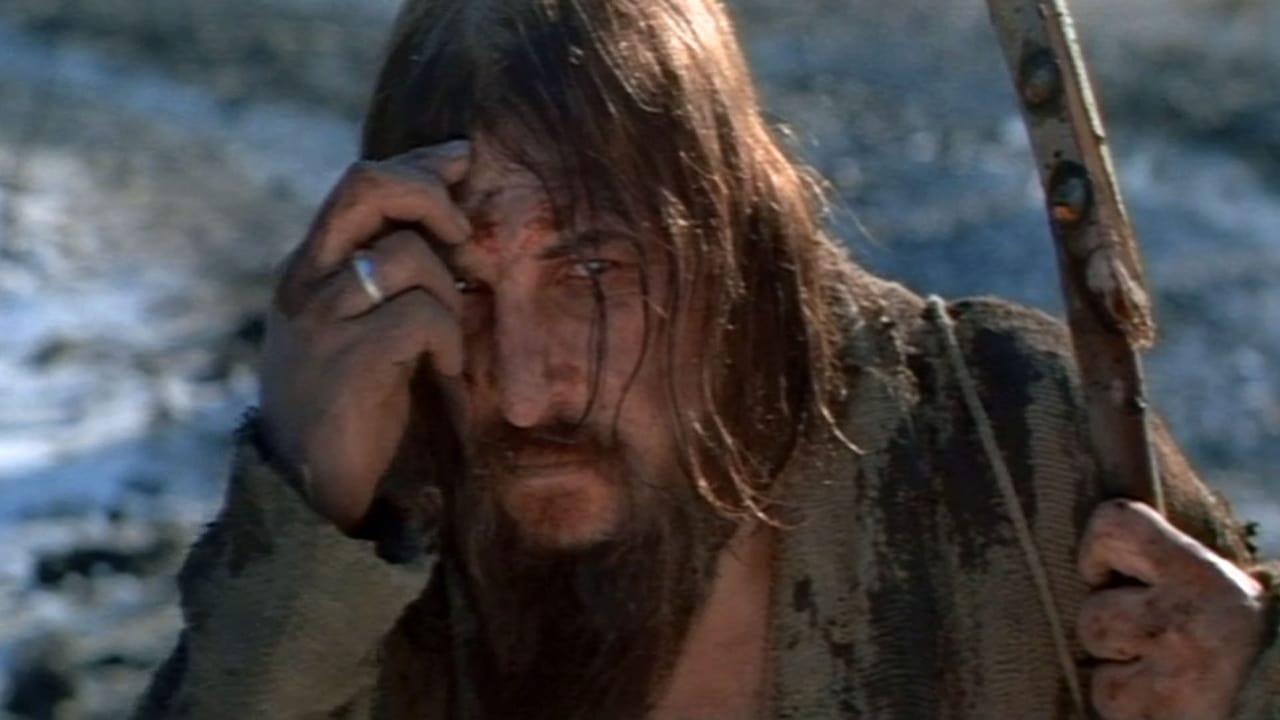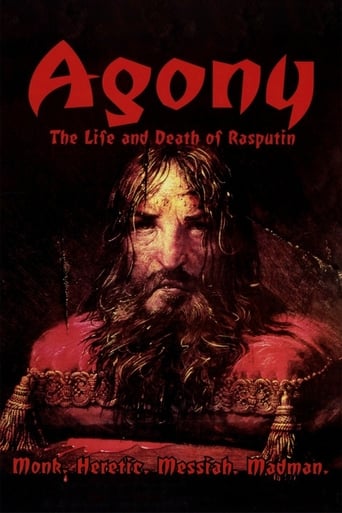

Many may not be aware that this film was considered "worthless" in the Soviet Union after it was made and shelved for years. Director Elem Klimov made several changes to the 1975 original version and it was ultimately released in 1981 and shown at the Venice Film Festival 1982 (where it won the FIPRESCI prize) out of competition.The original name of the film was Agony (Agoniya) and not Rasputin, a name by which the film was marketed for a while. The title Agony was evidently in line with what the director had in mind. If we were to accept that argument, was the director's original film about the spiritual agony of the controversial holy man? Or was it meant to reflect the agony of Czar Nicholas, who could not go against the Czarina's total faith in Rasputin? Was the title meant to depict the agony of a great nation afflicted by the abysmal corruption among the monarchists who were there to make money while the poor starved and the indecisive Czar painted flowers to distract himself from the more pressing political problems (One fine sequence in the film soon after the Duma castigates the Czar shows the silent but mentally tortured Czar, with tear filled eyes looking for comfort in the sympathetic gaze of his loyal butler). Was the title also to depict the agony of the Russian Orthodox Church which was suddenly losing its grip on the worshippers with the rise of the Bolsheviks and "holy men" like Rasputin? We will never know unless we see the original version the director made. My guess is the director wanted to combine all these agonies and that Rasputin, the individual, dominated only a segment of the agonizing events. What we do know is that this film and its many versions that were put out by Soviet and the post-Perestroika Russian authorities were at no point of time expected to depict Rasputin as the sole villain that led to the to the 1916 October Revolution.The film does offer several insights into the enigmatic character of Rasputin. He did indeed accept bribes from those wanting favors from the Czar, while the film distinctly indicates that it is debatable that he loved money and wealth. He was least concerned about getting rich, because he could get what he desired without pelf. Rasputin had an ability to foresee the future but could totally misread his dreams (The film includes an interesting sequence where he rolls in a pool of stagnant water, as he can foresee his fall from grace at the Czar's palace). He could perform small miracles, could utter saintly statements ("the cowl does not make a monk") and believed like a village bumpkin that you could sin and then start life with a clean slate! No wonder the Russian Orthodox Church saw in him an evil rascal. What happens to him after the Church traps him is totally unclear in the version of the film I saw. Was he castrated? Klimov's Rasputin is unusual--he is an animal waiting to ravish a beautiful woman one moment, and then a religious zealot throwing out the woman for having tried to seduce him the very next moment.I am convinced that Klimov's film is less about Rasputin than about the people that surrounded him. Take the Czar, for one.Klimov's cinematic essay shows him scurrying away from a meeting on war preparations in dark passageways behind wall-maps worried equally about his haemophiliac son Alexei, the crown prince who is depicted as a brat. The personal worries of the Czar (in the photography dark room, in his relationship with the Orthodox Church, his empathies for his worried wife doting on her children) have been given importance, unlike Franklin Schaffner's Nicholas and Alexandra that seemed to focus on the Czarina (Janet Suzman) more than the Czar. Interestingly, Klimov's film downplays the Czarina's role focusing more on the Czar.Klimov's range of agonies does not end here. Even the assassins of Rasputin are agonizingly guilt-ridden. Most Russians are Church-going Orthodox Christians and Klimov understood his audience quite well. The dubious role of the Orthodox Church in those troubled times are pitch forked into prominencethe film shows the burial of Rasputin officiated by the Church in the presence of the Czar.Finally, Klimov spliced documentary footage to show the agonies of the common man at every given interval to add validity to his essay on the varied agonies he captures on celluloid.While Klimov's film shows patches of brilliance, one needs to recall that he initially made his mark as filmmaker decades before Agoniya having made remarkable satirical comedies like Adventures of a dentist. (I have yet to see the latter film; however, what both films have in common is that wonderful Russian actress Alisa Frejnlikh, who played the Stalker's wife in Tarkovsky's Stalker.) His last few films Agoniya and Idi o simotri (Go and see/Come and see) proved that he was now looking at life grimly. He was then working closely with his wife, actor and director Larisa Shepitko and was reported to be a devoted husband. Equally enigmatic is the role of Lady Vyrubova played by Alisa Frejnlikh. What was the relationship between Rasputin and Vyrubova? Probably the answers lie in the director's cut of Agoniya, which is possibly lost for ever.I was privileged to have met Klimov at Hyderabad, India, in 1986 during a Film Festival. It was after his wife's death. I recall that he was withdrawn and less than forthcoming to questions. Was he afraid to talk? Was he a genius who was never allowed to prove it, because of political pressures? This is probably why both Agoniya and Klimov remain enigmatic for me to this day.
... View MoreI don't understand russian language and I'm not very familiar to russian history, but the events told in this film make a very strong and exciting experience. Much of this is due to Elem Klimovs very conscious use of cinematic methods. The mad monk (Rasputin) as an evil force in russian politics is portrayed with great force. Klimov seems to be one of the great cinematic poets and dramatist who can tell a story of violent and dramatic political events, and also of private and psychological conditions. The actors are first rate in every aspect and make this cruel story a memorable, thrilling and moving experience. Agoniya means of course agony, and that is what the imperial family and the political elite in Russia went trough these years. Klimov had to do some compromises, but this film is in any way a masterpiece.
... View MoreThis film is so odd and bizarre that I was totally immersed in it. In actuality this is a basic story that deals with Siberian peasant 'Rasputin', the mystic whose ability to improve the condition of Aleksey Nikolayevich, the hemophiliac heir to the Russian throne, made him an influential favourite at the court of Emperor Nicholas II and Empress Alexandra. The actor who plays Rasputin is an evil duplicate, a man who is oozing virulence, he has a very charismatic smile that almost looks diabolical.He's a strange character and has a powerful influence on the Czar's family and Russian political life. As the viewer, we are left to wonder, 'what do these people see in him, how does he control them so?'. He soon makes enemies of the church, the state, and local husbands who do not take kindly to his debauchery and licentiousness. The director is brilliant in weaving a documentary montage of Russian events and the ending is one of the most powerful ever envisioned by a director.
... View More...but I speak the language fluently. Even so, I need the subtitles to get through this one. Petrenko is VERY convincing as the mad monk.The plot is every bit as convoluted and murky as was Russian society in those days.It's a great film, one of my favorites from Russia/USSR...
... View More